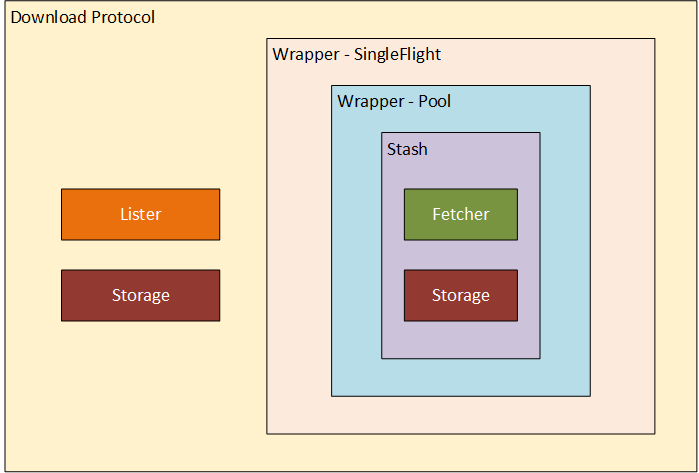From VCS to the User
You read about proxy, communication and then opened a codebase and thought to yourself: This is not as simple as described in the docs.
Athens has a set of architectural components that handle Go modules from their journey from the VCS into storage and down to the user. If you feel lost on how all these pieces work, read on my friend!
From communication, you know that when a module is not backed up in the storage it gets downloaded from VCS (such as github.com) and then it is served to the user. You also know that this whole process is synchronous. But when you read a code you see module fetchers and download protocol stashers and you struggle to figure out what’s what and how they differ. It might seem complicated, but this document will help explain everything that’s going on.
Components
Let’s start with describing all the components you will see along the way. There’s no better way to get a clear picture of everything than with a diagram.
As you can see, there are a lot of layers and wrappers. The first two pieces you’ll see in the code are the Storage and the Fetcher. We’ll start our journey there.
Storage
Storage is what it sounds like. Storage instance created in proxy/storage.go’s GetStorage function.
Based on storage type passed as an ENV variable it will create in-memory, filesystem, mongo… storage.
This is where modules live. Once there, always there.
Fetcher
Fetcher is the first component on our way. As we can guess from the name, Fetcher (pkg/module/fetcher.go) is responsible for fetching the sources from VCS.
For this, it needs two things: the go binary and afero.FileSystem. Path to binary and filesystems are passed to Fetcher during initialization.
mf, err := module.NewGoGetFetcher(goBin, fs)
if err != nil {
return err
}app_proxy.go
When a request for a new module comes, the Fetch function is invoked.
Fetch(ctx context.Context, mod, ver string) (*storage.Version, error)fetch function
Then the Fetcher:
- creates a temp directory using an injected
FileSystem - in this temp dir, it constructs dummy go project consisting of simple
main.goandgo.modso thegoCLI can be used. - invokes
go mod download -json {module}
This command downloads the module into the storage. Once the download is completed,
- the
Fetchfunction reads the module bits from storage and returns them to the caller. - The exact path of module files is returned by
go modas part ofJSONresponse.
Stash
As it is important for us to keep components small and readable, we did not want to bloat Fetcher with storing functionality. For storing modules into a storage we use Stasher. This is the single responsibility of a simple Stasher.
We think it’s important to keep components small and orthogonal, so the Fetcher and the storage.Backend don’t interact. Instead, the Stasher composes them together and orchestrates the process of fetching code and then storing it.
The New method accepts the Fetcher and the storage.Backend with a set of wrappers (explained later).
New(f module.Fetcher, s storage.Backend, wrappers ...Wrapper) Stasherstasher.go
The code in pkg/stash/stasher.go isn’t complex, but it’s important:
I think this does two things:
- invokes
Fetcherto get module bits - stores the bits using a
storage
If you read carefully you noticed wrappers passed into a basic Stasher implementation.
These wrappers add more advanced logic and help to keep components clean.
The new method then returns a Stasher which is a result of wrapping basic Stasher with wrappers.
for _, w := range wrappers {
st = w(st)
}stasher.go
Stash wrapper - Pool
As downloading a module is resource heavy (memory) operation, Pool (pkg/stash/with_pool.go) helps us to control simultaneous downloads.
It uses N-worker pattern which spins up the specified number of workers which then waits for a job to complete. Once they complete their job, they return the result and are ready for the next one.
A job, in this case, is a call to Stash function on a backing Stasher.
Stash wrapper - SingleFlight
We know that module fetching is a resource-heavy operation and we just put a limit on a number of parallel downloads. To help us save more resources we wanted to avoid processing the same module multiple times.
SingleFlight wrapper (pkg/stash/with_singleflight.go) takes care of that.
Internally it keeps track of currently running downloads using a map.
If a job arrives and map[moduleVersion] is empty, it initiates it with a callback channel and invokes a job on a backing Stasher.
s.subs[mv] = []chan error{subCh}
go s.process(ctx, mod, ver)if there is an entry for the requested module, SingleFlight will subscribe for a result
s.subs[mv] = append(s.subs[mv], subCh)and once the job is complete, the module is served one level up to the download protocol (or to wrapping stasher possibly)
Download protocol
The outer most level is the download protocol.
dpOpts := &download.Opts{
Storage: s,
Stasher: st,
Lister: lister,
}
dp := download.New(dpOpts, addons.WithPool(protocolWorkers))It contains two components we already mentioned: Storage, Stasher
and one more additional: Lister.
Lister is used in List and Latest funcs to look upstream for the list of versions available.
Storage is here again. We saw it in a Stasher before, used for saving.
In Download protocol it is used to check whether or not the module is already present. If it is, it is served directly from storage.
Otherwise, Download protocol uses Stasher to download module, store it into a storage and then it serves it back to the user.
You can also see addons.WithPool in a code snippet above. This addon is something similar to Stash wrapper - Pool. It controls the number of concurrent requests proxy can handle.

